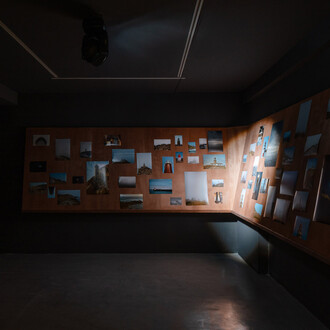NoguerasBlanchard is pleased to announce Empezar por el medio (Beginning in the middle) the first exhibition of Catalan artist Enric Farrés Duran in Madrid.
Empezar por el medio is an exhibition with a literary structure, articulated around El viaje frustrado (The frustrated journey) (2015), a film made by Enric Farrés Duran during the summer of 2015. Here, the artist remakes the journey narrated by Josep Pla (1897-1981) in the book Un viatge frustrat (published in 1927), in which he and his friend Sebastián Puig (known by the alias Hermós), toured the Costa Brava in 1918 from Calella de Palafrugell to France in a small sailing boat. Pla describes the voyage in meticulous detail along with the memorable moments lived in taverns and fishermen’s houses sharing stories and songs with friends and different characters. He also explains the main reason for his trip: visiting family members of Hermós in the French Roussillon. This purpose is truncated by Hermós himself when, having already arrived in French waters, he catches sight of what could have been a warship and, petrified that he’d be asked for a sailing liscence which he didn’t have, turns around and sets off back home. From this moment onwards Pla suspects that perhaps Hermós was using this as an excuse and that his main motivation was not so much to reach the destination, but to return to Calella to recount his story.
In the film El viaje frustrado, the artist Enric Farrés Duran, a native of Palafrugell and a descendent of Pla, was determined to reach the destination. To avoid a repetition of the failure of these two characters to reach Roussillon, Farrés Duran invested a navigation system that offered him a higher chance of success: his dinghy would be pulled at all times by a larger boat with sails and an engine, captained by a wellknown art collector. And that is how on the 3rd of August, at the height of the tourist season, Enric Farrés Duran and Josep Inglada set off from Calella de Palafrugell for France; Farrés Duran in a small wooden rowing boat and Inglada en a large sailing boat with an engine, one pulling the other. El viaje frustrado describes the odyssey carried out by the peculiar couple based on fragmentary filming and, while lacking any epic qualities, accentuates a holliday feeling, in which insubstantial moments that comprise ordinary time takes up most of the footage.
El viaje frustrado constitutes the radiography of a fiction, in which the concept of failure appears in a unique and contradictory manner: Farrés Duran’s approach is opposed to that of the Romantic artist who faces nature alone in search of the sublime, placing the value of the result ahead of the experience. El viaje frustrado however, analyzes the logic of success through irony, adapting to it and assuming the failure of the artist from the moment he starts being towed by the collector, alluding to the dynamics of power, dependence and precariousness so prevalent in the art system. The artist establishes a relationship of symbiosis with his tow boat and from his invisibility, is able to do other things, engaging in unproductive distractions along the way. His plan is meant as an honest recognition of the incapacity of the artist to be an emancipated agent: the impossibility of responding efficiently to the demands of a culture oriented towards achieving tangible results from the very practice of doing nothing, of letting things pass you by.
From this experience, Enric Farrés Duran has connected the works of Empezar por el medio produced during the summer months of the year 2018, again in a holiday context that generated a spiral movement between working and being on holliday. Through a methodology based on the observation of the environment and adopting parameters that don’t fit into those that society assumes as a symbol of productivity, the artist spent the summer structuring the content of the exhibition through a set of binomial relations such as surface and depth –Hice la mili de marinero en Madrid (I made the sailor mili in Madrid) (2018)– visibility and invisibility –Noche en Venecia (Night in Venice) (2018)– or the relationship between literature and the physicality of the landscape –Tú que pasas has de saber (You who pass has to know) (2018)–.
In 1954, Josep Pla decided to write a false fictional epitaph to his friend Hermós starting with an “Between 1917 and (…) he lived in these solitudes, (…)” and ending it with “If he didn’t come it’s because he couldn’t, or because he had been deceived.” From this point of departure and employing frottage on paper, Farrés Duran writes –without writing– Tú que pasas has de saber (2018), a collection of poems that, returning to the discourse its original use, shatters the very foundations of the idea of death through humor, at the same time endorsing Marcel Broothaers in the race started by the Symbolist poet Stéphane Mallarmé.
Once immersed in the body of the exhibition, we may discover that someone pulls the narrative thread to check the likeliness of this story in Anzuelo sin título (Untitled bait) (2018). On the other hand, the relationship between the artist and collector is revisited through a new tension in the installation El coleccionista, el artista y todo lo demás (The collector, the artist and everything else) (2018), this time without knowing who pulls who.
Finally, Farrés Duran offers an epilogue to the exhibition outside the gallery space: Hice la mili de marinero en Madrid (2018), an audio piece that accompanies the listener when sailing in the boats of the Retiro Park in Madrid. Here, a voice reveals the frustrated attempts of definitive journeys aborted, once again, by the promise of something that probably doesn’t exist. It is known that Pla and Hermós never actually made their trip.
















